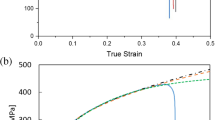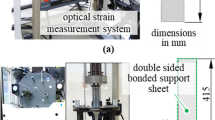Abstract
We investigated the impact of die fillet shape, fillet size, die clearance, and die height on the microstamping of ultrathin 316L bipolar plates (BPPs) with stepped flow channels. Using the normalized Cockcroft–Latham damage fracture criterion combined with the response surface method, we developed an effective predictive model for the fracture behavior of ultrathin 316L BPPs. This model was employed to optimize the mold parameters. Numerical simulation results reveal that different fillet shapes—90° sector, irregular sector, ellipse, and parabola—significantly affect the formation of ultrathin 316L BPPs. Among these, the elliptical fillet shape yielded the best results. Further analysis indicated that increasing the radius of the die fillet while reducing the die height led to decreases in the stress, strain, thinning rate, and damage value of the BPPs. Conversely, the draft angle increased linearly. However, with varying die clearance, the stress, strain, thinning rate, and damage value of the BPPs initially decreased and then increased, while the draft angle continued to rise linearly. The optimized die parameters were identified using the damage prediction model: a fillet radius of 0.2 mm, clearance of 0.26 mm, height of 0.49 mm, and stepped height of 0.24 mm. The validity of these optimized parameters was confirmed experimentally.























Similar content being viewed by others
Data availability
All data generated or analyzed during this study are included in this published article.
Code availability
Not applicable.
References
Henning LB, Kevin S, Michael D, Liu XY, Amgad E, Michael W, Thomas W, Brad R, Martha C (2020) Automotive fuel cell stack and system efficiency and fuel consumption based on vehicle testing on a chassis dynamometer at minus 18°C to positive 35°C temperatures. Int J Hydrogen Energy 45(1):861–872. https://doi.org/10.1016/j.ijhydene.2019.10.150
Zhao YX, Peng LF (2019) Formability and flow channel design for thin metallic bipolar plates in PEM fuel cells: Modeling. Int J Hydrogen Energy 43(7):2592–2604. https://doi.org/10.1002/er.4226
Li XN, Lan SH, Xu ZT, Jiang TH, Peng LF (2019) Thin metallic wave-like channel bipolar plates for proton exchange membrane fuel cells: Deformation behavior, formability analysis and process design. J Power Sources 444:227217. https://doi.org/10.1016/j.jpowsour.2019.227217
Alo OA, Otunniyi IO, Pienaar H (2019) Manufacturing methods for metallic bipolar plates for polymer electrolyte membrane fuel cell. Mater Manuf Process 34(8):927–955. https://doi.org/10.1080/10426914.2019.1605170
Yu L, Ming PW, Yang DJ, Zhang CM (2020) Stainless steel bipolar plates for proton exchange membrane fuel cells: Materials, flow channel design and forming processes. J power sources 451:227783. https://doi.org/10.1016/j.jpowsour.2020.227783
Liu QS, Lan FC, Zeng CJ, Chen JQ, Wang JF (2022) A review of proton exchange membrane fuel cell’s bipolar plate design and fabrication process. J Power Sources 538:231543. https://doi.org/10.1016/j.jpowsour.2022.231543
Talebi-Ghadikolaee H, Naeini HM, Mirnia MJ, Mirzai MA, Gorji H, Alexandrov S (2020) Fracture analysis on U-bending of AA6061 aluminum alloy sheet using phenomenological ductile fracture criteria. Thin-Walled Struct 148:106566. https://doi.org/10.1016/j.tws.2019.106566
Talebi-Ghadikolaee H, Elyasi M, Mirnia MJ (2020) Investigation of failure during rubber pad forming of metallic bipolar plates. Thin-Walled Struct 150:106671. https://doi.org/10.1016/j.tws.2020.106671
Elyasi M, Ghadikolaee HT, Hosseinzadeh M (2018) Investigation of dimensional accuracy in forming of metallic bipolar plates with serpentine flow field. Int J Adv Manuf Tech 96:1045–1060. https://doi.org/10.1007/s00170-018-1650-5
Sudarsan C, Prasad KS, Hazra S, Panda SK (2020) Forming of serpentine micro-channels on SS304 and AA1050 ultra-thin metallic sheets using stamping technology. J Manuf Processes 56:1099–1113. https://doi.org/10.1016/j.jmapro.2020.05.013
Guo N, Zhang XL, Hou ZR, Wang WY, Yang DJ, Min JY, Ming PW, Zhang CM (2023) Hot stamping of ultra-thin stainless steel sheets for bipolar plates[J]. J Mater Proc Technol 317:117987. https://doi.org/10.1016/j.jmatprotec.2023.117987
Chul KJ, Ja YK, Chung GK (2014) Fabrication of stainless steel bipolar plates for fuel cells using dynamic loads for the stamping process and performance evaluation of a single cell. Int J Hydrogen Energy 39(36):21461–21469. https://doi.org/10.1016/j.ijhydene.2014.04.103
Khatir FA, Barzegari MM, Talebi-Ghadikolaee H, Seddighi S (2021) Integration of design of experiment and finite element method for the study of geometrical parameters in metallic bipolar plates for PEMFCs. Int J Hydrogen Energy 46(79):39469–39482. https://doi.org/10.1016/j.ijhydene.2021.09.161
Yang HD, Jiang TH, Xu ZT, Peng LF (2022) A robust design of the forming process parameters of the metallic bipolar plate for proton exchange membrane fuel cells. Int J Hydrogen Energy 47(97):41154–41169. https://doi.org/10.1016/j.ijhydene.2022.09.186
Zhang P, Pereira MP, Rolfe BF, Wilkosz DE, Hodgson P, Weiss M (2022) Investigation of material failure in micro-stamping of metallic bipolar plates. J Manuf Proc 73:54–66. https://doi.org/10.1016/j.jmapro.2021.10.044
Zhang RQ, Shao ZT, Lin JG (2018) A review on modelling techniques for formability prediction of sheet metal forming. Int J Light Mater Manuf 1(3):115–125. https://doi.org/10.1016/j.ijlmm.2018.06.003
Gao PF, Guo J, Zhan M (2020) Microstructure and damage based constitutive modelling of hot deformation of titanium alloys. J Alloys Compd 831:154851. https://doi.org/10.1016/j.jallcom.2020.154851
Zhou J, Mu Y, Wang B (2017) A damage-coupled unified viscoplastic constitutive model for prediction of forming limits of 22MnB5 at high temperatures. Int J Mech Sci 133:457–468. https://doi.org/10.1016/j.ijmecsci.2017.09.006
Wu PF, Lou YS, Chen Q, Ning HQ (2022) Modeling of temperature- and stress state-dependent yield and fracture behaviors for Mg-Gd-Y alloy. Int J Mech Sci 229:107506. https://doi.org/10.1016/j.ijmecsci.2022.107506
Li R, Zheng Z, Zhan M, Zhang HR, Cui XL, Lei YD (2022) Fracture prediction for metal sheet deformation under different stress states with uncoupled ductile fracture criteria. J Manuf Processes 73:531–543. https://doi.org/10.1016/j.jmapro.2021.11.023
Chen XW, Du YQ, Du KX, Xiang N, Li ZP, Tian XH, Liu MX (2022) An enhanced lemaitre damage model and verification method for X12 alloy steel in hot forming process. Eng Fract Mech 273:108711. https://doi.org/10.1016/j.engfracmech.2022.108711
Terhorst M, Feuerhack A, Trauth D, Klocke F (2016) Extension of the normalized Cockcroft and Latham criterion with temperature dependent critical damage values for predicting chevron cracks in solid forward extrusion. Int J Mater Form 9(4):449–456. https://doi.org/10.1007/s12289-015-1231-1
Niemsakul S, Sae-Eawa N, Aue-U-Lan Y (2018) Determination and analysis of critical damage criteria for predicting fracture in forming process by uniaxial tensile test. Mater Today: Proc 5(3/2):9642–9650. https://doi.org/10.1016/j.matpr.2017.10.152
Chutwin A, Sansot P, Tanakorn J (2018) Polar effective plastic strain-forming limit diagram of DP 440 steel sheet with application to two-step forming test. Mater Today: Proc 77(4):1039–1104
Yan Y, Wang H, Li Q (2015) The inverse parameter identification of Hill 48 yield criterion and its verification in press bending and roll forming process simulations. J Manuf Process 20(OCT.PT.1):46–53. https://doi.org/10.1016/j.jmapro.2015.09.009
Lee HR, Lee MG, Park N (2023) Effect of evolutionary anisotropic hardening on the prediction of deformation and forming load in incremental sheet forming simulation. Thin Wall Struct 111231. https://doi.org/10.1016/j.tws.2023.111231
Dai E, Lv ZQ, Yuan PP, Liu GQ, Guo LZ, Tang BT (2023) Ductile fracture of anisotropic QP980 steel sheet by using the isotropic/anisotropic modified Mohr-Coulomb models. Eng Fract Mec 290:109522. https://doi.org/10.1016/j.engfracmech.2023.109522
Zhao FQ, Dong HQ, Tian HG, Zhao XJ, Wang HW (2022) Influence of operation parameters on performance of variable section stepped flow channel fuel cell. Ionics 28(4):1887–1901. https://doi.org/10.1007/s11581-021-04417-y
Yan Y, Wang H, Li Q (2015) The inverse parameter identification of Hill 48 yield criterion and its verification in press bending and roll forming process simulations. J Manuf Proc 20(1):46–53. https://doi.org/10.1016/j.jmapro.2015.09.009
Zhang DM, Zhang MH, Lin R, Liu GL, Li J, Feng YL (2021) Strengthening and strain hardening mechanisms of a plain medium carbon steel by multiscale lamellar structures. Mater Sci Eng 827:142091. https://doi.org/10.1016/j.msea.2021.142091
Li LH, Wang J, Zhang SQ (2020) Numerical simulation for deformation characteristics and fracture prediction of perforated sheet in incremental sheet punching. Int J Adv Manuf Tech 110:1415–1427. https://doi.org/10.1007/s00170-020-05908-4
Xie WL, Jiang WH, Wu YF, Song HW, Deng SY, Lazarescu L, Zhang SH, Banabic D (2022) Process parameter optimization for thin-walled tube push-bending using response surface methodology. Int J Adv Manuf Tech 118:3833–3847. https://doi.org/10.1007/s00170-021-08196-8
Xu YF, Peng LF, Yi PY, Lai XM (2016) Analysis of the flow distribution for thin stamped bipolar plates with tapered channel shape. Int J Hydrogen Energy 41(9):5084–5095. https://doi.org/10.1016/j.ijhydene.2016.01.073
Acknowledgements
This work was supported by the Major Special Projects of Public Bidding in Shanxi Province (No. 20201101020) and the Central Guidance on Local Science and Technology Development Fund Project (No.YDZJSX2022A053).
Funding
This work was supported by the Major Special Projects of Public Bidding in Shanxi Province (No. 20201101020) and the Central Guidance on Local Science and Technology Development Fund Project (No.YDZJSX2022A053).
Author information
Authors and Affiliations
Contributions
Fuqiang Zhao offered the project, were in charge of the guidance and final check. Zhiying Gao was in charge of the whole research and wrote the manuscript. Qingxue Huang, Xiujian Cheng and Heng Zhang assisted with the analysis and validation. Chunhong Ma, Shuaifeng Chen and Xiaofeng Ding gave some advice on the manuscript. All authors read and approved the final manuscript.
Corresponding author
Ethics declarations
Ethics approval
The authors confirm that this work does not contain any studies with human participants performed by any of the authors.
Consent to participate
Not applicable.
Consent for publication
The author grants the publisher the sole and exclusive license of the full copyright in the contribution, which license the publisher hereby accepts.
Competing interests
The authors have no relevant financial or non-financial interests to disclose.
Additional information
Publisher's Note
Springer Nature remains neutral with regard to jurisdictional claims in published maps and institutional affiliations.
Rights and permissions
Springer Nature or its licensor (e.g. a society or other partner) holds exclusive rights to this article under a publishing agreement with the author(s) or other rightsholder(s); author self-archiving of the accepted manuscript version of this article is solely governed by the terms of such publishing agreement and applicable law.
About this article
Cite this article
Zhao, F., Gao, Z., Huang, Q. et al. Optimizing die parameters of microstamping process for PEMFC 316L bipolar plate using NCL fracture criterion and response surface methodology. Int J Adv Manuf Technol 132, 1679–1696 (2024). https://doi.org/10.1007/s00170-024-13461-7
Received:
Accepted:
Published:
Issue Date:
DOI: https://doi.org/10.1007/s00170-024-13461-7




